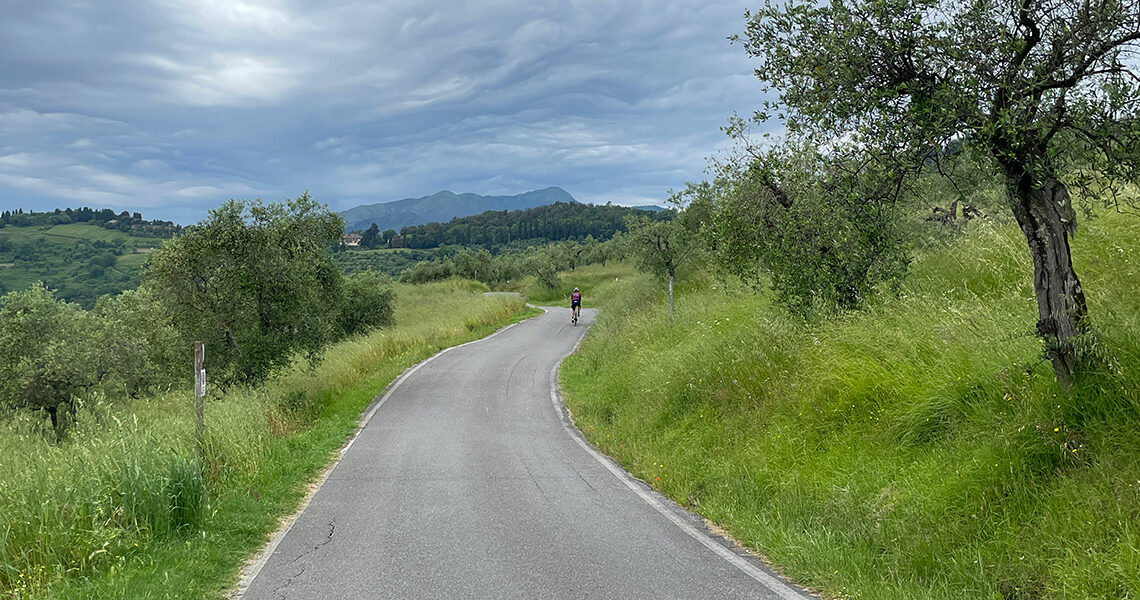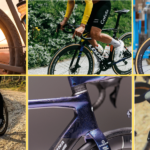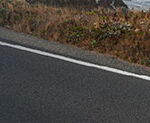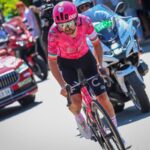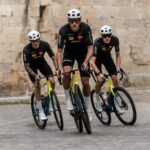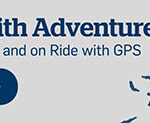
After 30+ years travelling to Italy to chase multiple Giro’s, ride events, visit brands and attend product launches, plus a few holiday trips, I’ve learned a lot about most regions of the country, how to get around, and more importantly, where to ride and where to stay. This article has some of my own personal tips and tricks on how I plan the best Italian cycling holiday.

View east from Viareggio towards Carrara and the Appenine mountains – your choice to ride flats all day north and south along the coast, or head inland for all the climbing you can handle.
Why Italy?
This probably needs no explaining to regular readers, but for me it went like this… I fell in love with Italy in 1986, biking through Europe after college. After a rough patch in Switzerland (being robbed, then locked out of my hostel), I landed in Florence and was immediately struck by the people, the food, the freedom, and the cycling culture. Fast forward to 1994 – my first trip to chase the Giro d’Italia. I was hooked. Seeing Pantani burst onto the scene while riding and chasing stages every day changed everything. Since then, I’ve returned countless times to ride (literally I’ve lost count – including when I lived Bergamo in 1997), explore, and soak in Italy’s passion for the bike, and more importantly – life.
Choose Your Region: Where to Ride
Italy is a cyclist’s paradise, and no two regions are alike. Whether it’s your first trip or your fifth, here are a few top areas I think everyone should visit:
Tuscany: Classic Rolling Hills and White Roads
There’s a reason Tuscany is the most talked about region when it comes to favorite places to visit – more than rolling hills and cypress-lined lanes, did you know Tuscany has everything from high mountains to wide sandy beaches? Also the home of the legendary Strade Bianche – white gravel roads that should be ridden at least once in your life. When you make a list of places to ride that “literally have it all” – Tuscany is it – all the terrain, scenery, and culture-rich towns like Lucca, Pisa, Siena and Florence.

During the 2025 Giro d’Italia, I stayed in Viareggio on the west coast, next to the Gulf of Genoa, and within riding distance of Lucca and Pisa, at the Hotel Residence Esplanade. I saw three stages and will have a separate story on this later. I found the hotel through Italy Bike Hotels, a group of over 50 bike hotels around Italy.
 As part of the Italy Bike Hotels group, each member hotel meets a specific criteria to deliver a high level of service and amenities for cyclists. With over 50 hotels in the group, cyclists can find an IBH hotel in almost every region of Italy – from the Alps and Dolomites in the north to Sicily and Puglia in the south, and the hilly regions and beaches in between. Each hotel offers a dedicated bike room, a fleet of rental bikes (road, gravel, e-bike and mtb) and bike manager responsible for looking after cycling guests needs. Some have onsite mechanics so setting up a rental bike is no problem.
As part of the Italy Bike Hotels group, each member hotel meets a specific criteria to deliver a high level of service and amenities for cyclists. With over 50 hotels in the group, cyclists can find an IBH hotel in almost every region of Italy – from the Alps and Dolomites in the north to Sicily and Puglia in the south, and the hilly regions and beaches in between. Each hotel offers a dedicated bike room, a fleet of rental bikes (road, gravel, e-bike and mtb) and bike manager responsible for looking after cycling guests needs. Some have onsite mechanics so setting up a rental bike is no problem.
Ride options can vary between daily posted rides suited to different distances and rider experience, to dedicated management for private groups, to teeing up your ride needs with local guides who work with each hotel. Other services include daily laundry to wash your by the next morning, hearty and nourishing breakfasts, post ride pasta bars. Many of the hotels offer their own custom cycling kits.
Because “wellness” is so popular in Italy, you’re sure to find a dedicated spa and massage services in the group hotels as well – these come in handy after a long day in the saddle.
 The Trek-Lidl team stays here whenever a race comes through, and the returning presence of a pro team is always a sign that the hotel delivers on a high level.
The Trek-Lidl team stays here whenever a race comes through, and the returning presence of a pro team is always a sign that the hotel delivers on a high level.
The riding here is excellent – a complete mix of flat coastal roads, rolling hills and big climbs into the marble laden mountains above places like Carrara. The ancient walled city of Lucca is within 30km, and Pisa about the same. I’ll have more on this hotel coming soon – but the mix of beach (over 20km of summer seaside fun along the coast), climbs, must-see cities, and easy access from Pisa airport make this a highly desirable destination for just riding or to enjoy a family holiday.
When to Visit: March – June, Sept-Oct – Tuscany has a long spread of sunny days and nice riding weather. Locals on the coast ride year round, dressed appropriately. It’s just July and August that get really hot – we’re talking 38C+ inland, low 30s celsius on the coast.
 Bonus points awarded when the Giro rolls right past your hotel’s front door.
Bonus points awarded when the Giro rolls right past your hotel’s front door.
The Adriatic’s Italian Riviera

Many PEZ-Fans will know the riding from Cesenatico south to Rimini and Riccione – as this section of wide sandy beachside recreation is home to some of Italy’s best and oldest bike hotels.

Home of the Gran Fondo Nove Colli – known for its 9 tough climbs – the region is filled with rolling hills, usually within a 10km ride from wherever you’re staying. It’s also home to Marco Pantani’s favorite training climb – the Carpegna – 10km of steepness you’d best have trained for – if you want to take in one the best descents you’ll ride down the other side.

The old center of Rimini is easily walkable, and where the locals go for an apertivo and dinner.
Another Italy Bike Hotel member I visited was the Oxygen Lifestyle Hotel in Rimini, on the east coast in the Italian Riviera. I’ll have more about this hotel coming later, and I was really impressed with the high level of service they deliver for cyclists.
 The Oxygen Lifestyle hotel is just across from the beach and has a full fleet of Bianchi’s for rent, guided rides and excellent food – everything you need.
The Oxygen Lifestyle hotel is just across from the beach and has a full fleet of Bianchi’s for rent, guided rides and excellent food – everything you need.
Rimini is located within site and riding distance of the Principality of San Marino – which is worth a visit once. These days it’s crowded with tour buses, but it’s distinct geographic silhouette is visible from miles around, and serves as a good reference point if you find yourself off track and without cell coverage. To avoid San Marino’s crowds, I prefer the small hilltop towns that dot the region… like Longiano.
 The ancient hill town of Longiano was about an hour’s ride from the coast, and served as coffee stop, and prime view point before we carried on in the local hills.
The ancient hill town of Longiano was about an hour’s ride from the coast, and served as coffee stop, and prime view point before we carried on in the local hills.
Getting here is easy enough – about a 90 minute drive from the Bologna airport (less if I’m driving), or even easier from the regional airport in Rimini.
When to Visit: March – June, Sept-Oct – The coastal Adriatic has temperate weather and lots of sun – so riding from March through October is fair game. Again it’s July and August that are really hot – plus the hotels tend to be crammed full of families on holiday.
Dolomites & Alps: Home of Epic Climbs and Giro Legends

For pure climbing glory, head north to the Italian Alps and Dolomites. Once I learned of the historic battles fought between the likes of Bartali, Coppi, and later Merckx on climbs like the Stelvio, Gavia, Mortirolo, and Zoncolan, my desire to ride these climbs myself became too strong to ignore. Pedalling these epic roads means unavoidable suffering – but the a rewards are worth it.
Planning your trip around an event is a great idea, and Italy invented the “gran fondo”. Riding the Maratona Dolomiti was one of my most feared, and most rewarding days on my bike. The weather can change fast (so unlike the rest of Italy, July – August are good bets for good weather here), and the Maratona organizers recently instigated a “rain jacket carry rule” for all riders, but that just adds to the epic-ness of it all.
The climbs range from super hard – like Passo Fedaia with grades over 12%, to scenic swoopers like the Passo Pordoi. Most of the climbs loop around what’s called the “Sella Ring” – the road connecting all the climbs in a big loop, and you can take in chunks of 50km, 80, 120 – as you like.
Best time to visit: End of May, June, and July. The weather in the high mountains tend to be less predictable from August onwards, but you can still finds some nice stretches.
Italy Bike Hotels has several options for places to stay in the Dolomites.

Further west in the Italian Alps, the climbs are longer and higher. The Passo Mortirolo is iconic to Giro fans. But don’t be mislead by the pastoral slopes – it’s 10km at 10% average grade is for my money, one of the hardest climbs I’ve ridden. But I’d do it again.

The Passo Gavia is where Andy Hampsten launched his winning bid for the 1988 Giro, and is another must do climb. Bormio makes a great base to reach all of these climbs.
 Near the top of the Gavia, but still a ways to go.
Near the top of the Gavia, but still a ways to go.
 The mighty Passo Stelvio is not to be taken lightly, at 2700m and still snow in late May, but well worth the effort. Consider the Mountain Design Hotel Alù in Bormio as a great base to reach all of these climbs.
The mighty Passo Stelvio is not to be taken lightly, at 2700m and still snow in late May, but well worth the effort. Consider the Mountain Design Hotel Alù in Bormio as a great base to reach all of these climbs.
Lake District: Lago di Garda

I’ve done a lot of riding around Lake Como and Lago di Garda, and love both places for different reasons. Lake Como has a certain aristocratic vibe to it that taps you into Old Italian money. Come for the the Giro di Lombardia in the Fall (October 11, 2025), to enjoy cooler riding weather (the summer heat here is oppressive), spectacular colors as the leaves turn, and hearty dishes from the region like Risotto Milanese and creamy polenta.
 Part way up Monte Baldo on Lake Garda.
Part way up Monte Baldo on Lake Garda.
You must see the Madonna del Ghisallo church and museum – situated on the climb above Bellagio, and along the route of the Giro di Lombardia.
Less than 2 hours drive east will land you at Lago di Garda, where more excellent lakeside riding awaits, including some huge climbs like Monte Baldo, and rolling hills of the Valpolicella wine region. Life around the lake is a great place to chill, and if you need a livelier vibe – Verona is just 20km away.
Best time to visit: End of May, June, and July, Sept & Oct. I’ve ridden here in May, March after Milan-San Remo, and the Fall for Giro di Lombardia. All are excellent times to visit, but October days can be really nice (20C+ degrees), or really wet – but I’d still go to see the race and enjoy the hearty local cuisine and a nice glass of Amarone.
The Pisa airport is just north of Livorno (left of the frame) and its smaller size offers easier access and cheaper flights. This is my view flying down from a couple days at the Mips Test Lab in Sweden.
Getting There & Getting Around
I’ve flown into most of the big airports and lots of smaller ones too, but the easiest way to land in Italy from North America’s west coast is through one of Europe’s main flight hubs like Frankfurt, Heathrow or Amsterdam. I favor the German routing due to quick connecting flights to most points in Italy – Munich is a better, newer and easier to navigate airport then Frankfurt.
With so much great riding in Italy’s north, I often start my trip by connecting to Milan (1 hour flight), Turin, Venice, Verona, or recently Pisa. Depending on where my trip starts, I like to keep my travel time as short as possible, and maximize time on the ground.
Milan Malpensa is the big northern Italian hub, but is a 40 minute drive from downtown Milan, while Linate Airport is basically right next to the city – and my preferred landing spot if I can find a flight there.
Once there, I usually rent a car. While I hear many people are afraid of Italian drivers, I’ve found them to be way better than what you find in America. Literally every time I drive from SFO down to Monterey for Sea Otter, I’ll experience multiple idiots passing on the right (or the shoulder), cutting me off, driving way too fast, or way too slow and generally oblivious to anyone else on the road. Now that’s dangerous.
By comparison, the Italian highways are 2-3 lanes wide, with narrow shoulders, and people drive fast. But – most people understand and respect the rules – and each other. Slow drivers stick to the right lanes, the left lane is strictly for passing, or high speed travel. I usually prefer the left lane myself, but even cruising at 150kmh, I’ll still get an occasional flash of high-beams in my rear view mirror – and I immediately pull over and let them pass when it’s safe.
Most travel between cities is 2-4 hours. I can drive from Milan to Venice in under 3 hours, so getting to many riding hotspots is pretty quick.
I like my own vehicle, which also allows the freedom to explore a region when I’m not riding. The Italian trains are great – they connect everything, and are pretty quick and comfortable – but travelling by train with a bike is a bit too much labor for my liking.
Most hotels offer a shuttle service as well, so I will often book a car for just part of my trip, and rely on other forms of transportation for days when I’m staying in one place.
Bring or Rent a Bike?
It’s been a few years now since I last travelled with my own bike. The hassle of packing / unpacking it at both ends, worries about airline damage, and don’t get me started on the exorbitant fees they charge to fly a bike these days.
 A full fleet of rental bikes is a good sign that there’s no reason to travel with you own bike amy more. The Hotel Oxygen has a Bianchi in your size.
A full fleet of rental bikes is a good sign that there’s no reason to travel with you own bike amy more. The Hotel Oxygen has a Bianchi in your size.
Once I relaxed my too-rigid standards for bike fit and saddle preference, I realized I have just as much fun riding a borrowed or rented bike as I do my own. Sure, a lot of Italians still run 25mm tires (versus the 28’s most of us run now), but aside from a bit harsher ride, all the decent bike hotels offer a variety of mid- to high-end road, gravel, mtb and e-bikes to rent from big name brands like Scott, Bianchi, Pinarello and more. In fact, I’ve found some great opportunities to test ride some cool boutique brands I’d normally not have access to back home.
With so many good bike options available after I’ve landed, nowadays all I take me is 2-3 kits, my pedals and a few tools. Also remember that flying with C02 cartridges is not allowed by the airlines – but flying with an electric mini-pump is ok, like the Cycplus AS2Pro I reviewed here.
Where to Stay: Bike Hotels
Bike hotels have transformed the experience of cycling in Italy. The Italy Bike Hotels group has options you can count on for great accomodation and bike service to let you explore all the regions of this country. I’ve stayed in around 10 of them, and the experience is always elevated by the personal attention you get when the owner is actually there, staff who stay around and begin to feel like family, and cyclist-first amenities. If you want convenience, support, and being looked after by people who actually care that you have a good experience, this is the way to go.
Conclusion: La Dolce Vita on Two Wheels
Italy is more than a cycling destination—it’s an experience. From the food and the people to the roads and races, it’s a place every cyclist should explore. Use this guide as your starting point, and start planning that dream trip. Because once you ride in Italy, you’ll understand why I keep going back. Hopefully this guide helps you plan your best Italian cycling holiday – and please feel welcome to drop my a question at Content@PezCyclingNews.com
**SPECIAL OFFER for PEZ Readers**
We are partnering with Italy Bike Hotels to offer PEZ-Fans a €100 credit towards your next stay with them. Click the banner, and add your name to their email list to receive info on how to claim the credit.
The post How to Plan Your Best Cycling Trip to Italy appeared first on PezCycling News.
